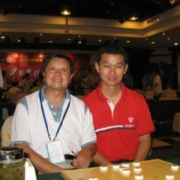
Lunar eclipse:
A lunar eclipse occurs when the Moon passes behind the Earth sothat the Earth blocks the Sun's rays from striking the Moon. Thiscan occur only when the Sun, Earth, and Moon are aligned exactly,or very closely so, with the Earth in the middle. Hence, a lunareclipse can only occur the night of a full moon. The type andlength of an eclipse depend upon the Moon's location relative toits orbital nodes. The most recent total lunar eclipse occurred onJune 15, 2011; it was a central eclipse, visible over Europe andSouth America after sunset, over Africa and most of Asia, andAustralia before sunrise. It lasted 100 minutes. The previous totallunar eclipse occurred on December 21, 2010, at 08:17 UTC.[1]
Unlike a solar eclipse, which can only be viewed from a certainrelatively small area of the world, a lunar eclipse may be viewedfrom anywhere on the night side of the Earth. A lunar eclipse lastsfor a few hours, whereas a total solar eclipse lasts for only a fewminutes at any given place, due to the smaller size of the moon'sshadow.
Types of lunar eclipse :
The shadow of the Earth can be divided into two distinctive parts:the umbra and penumbra. Within the umbra, there is no direct solarradiation. However, as a result of the Sun’s large angular size,solar illumination is only partially blocked in the outer portionof the Earth’s shadow, which is given the name penumbra. Apenumbral eclipse occurs when the Moon passes through the Earth’spenumbra. The penumbra causes a subtle darkening of the Moon'ssurface. A special type of penumbral eclipse is a total penumbraleclipse, during which the Moon lies exclusively within the Earth’spenumbra. Total penumbral eclipses are rare, and when these occur,that portion of the Moon which is closest to the umbra can appearsomewhat darker than the rest of the Moon.
As seen by an observer on Earth on the imaginary celestial sphere,the Moon crosses the ecliptic every orbit at positions called nodestwice every month. When the full moon occurs in the same positionat the node, a lunar eclipse can occur. These two nodes allow twoto five eclipses per year, parted by approximately six months.(Note: Not drawn to scale. The Sun is much larger and farther awaythan the Moon.)
A total penumbral lunar eclipse dims the moon in direct proportionto the area of the sun’s disk blocked by the earth. This comparisonshows the southern shadow penumbral lunar eclipse of January 1999(left) to the same moon outside of the shadow (right) demonstratesthis subtle dimming.
A partial lunar eclipse occurs when only a portion of the Moonenters the umbra. When the Moon travels completely into the Earth’sumbra, one observes a total lunar eclipse. The Moon’s speed throughthe shadow is about one kilometer per second (2,300 mph), andtotality may last up to nearly 107 minutes. Nevertheless, the totaltime between the Moon’s first and last contact with the shadow ismuch longer, and could last up to 4 hours.[2] The relative distanceof the Moon from the Earth at the time of an eclipse can affect theeclipse’s duration. In particular, when the Moon is near itsapogee, the farthest point from the Earth in its orbit, its orbitalspeed is the slowest. The diameter of the umbra does not decreaseappreciably within the changes in the orbital distance of the moon.Thus, a totally eclipsed Moon occurring near apogee will lengthenthe duration of totality.
 爱华网
爱华网



